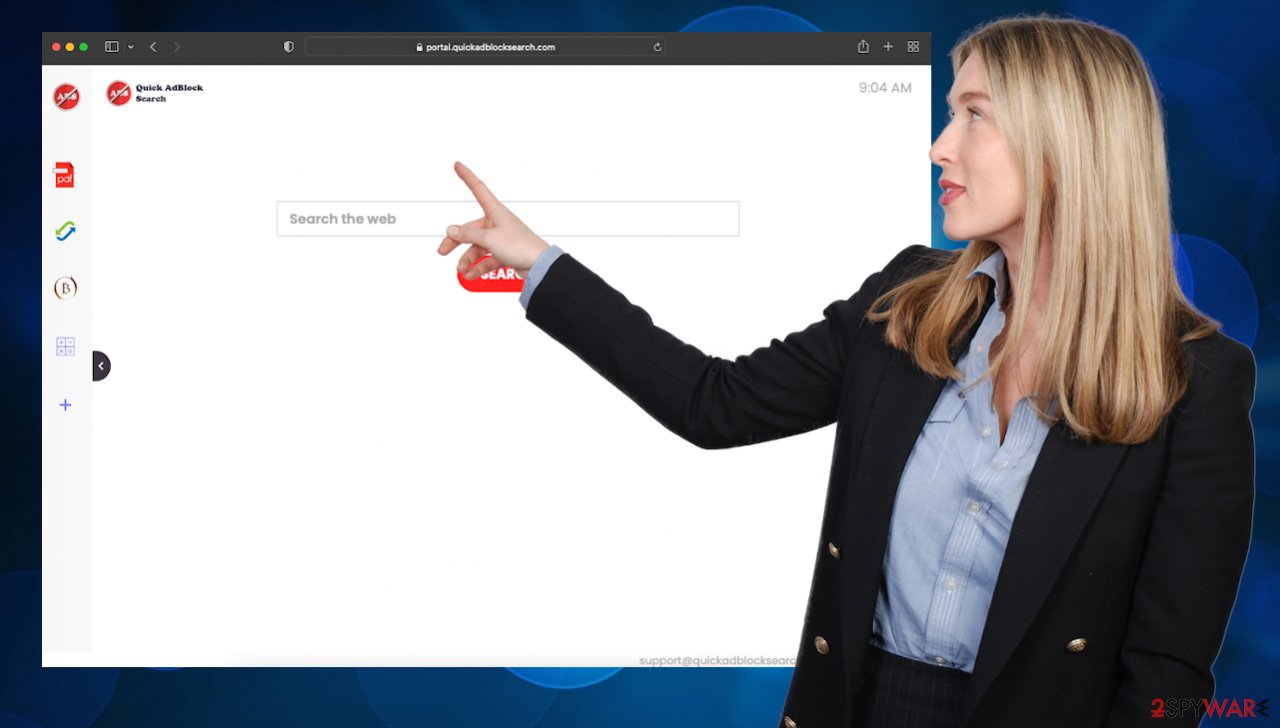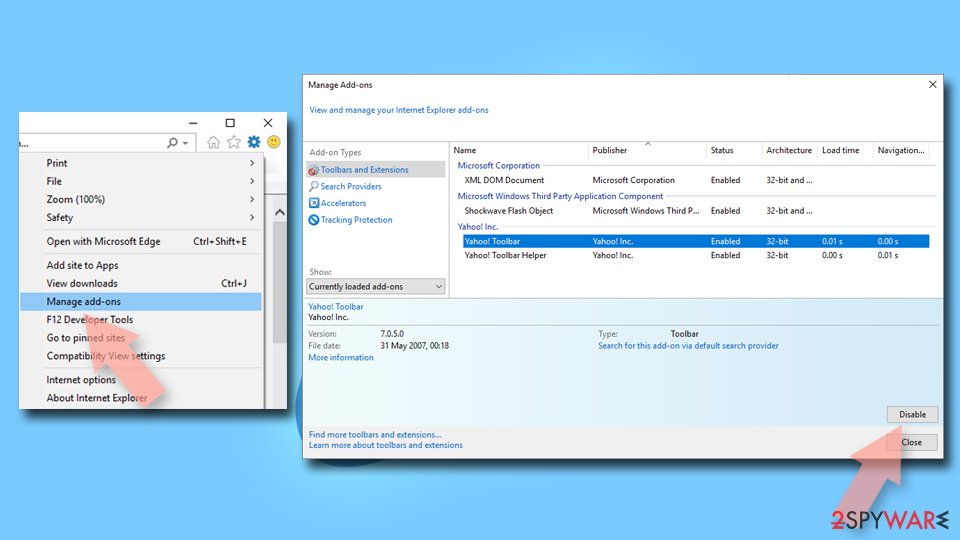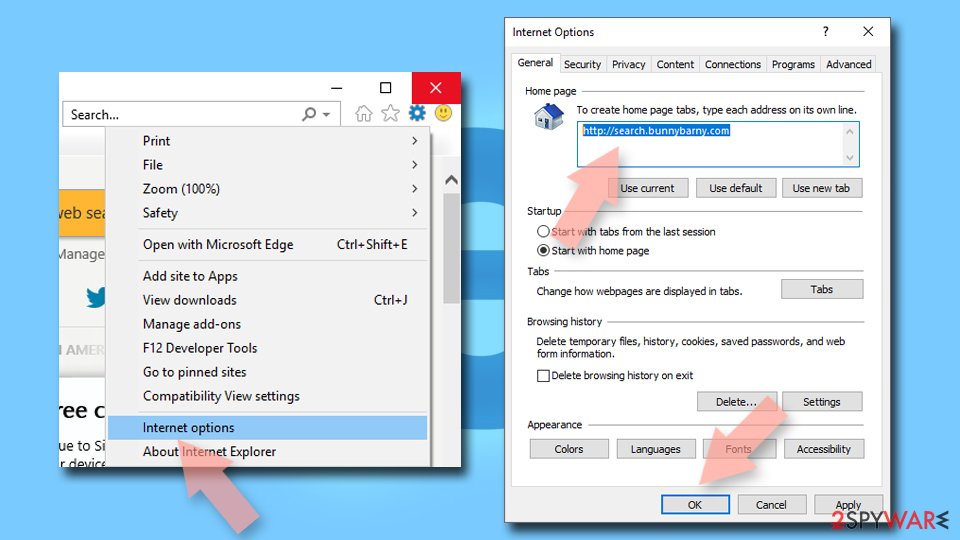QuickAdBlockSearch browser hijacker (spam) - Chrome, Firefox, IE, Edge
QuickAdBlockSearch browser hijacker Removal Guide
What is QuickAdBlockSearch browser hijacker?
QuickAdBlockSearch is the browser hijacker or a potentially unwanted program, not a valuable tool

QuickAdBlockSearch browser hijacker is the application that manipulates settings and preferences on web browsing tools to inject ads and sponsored material to lists of search results. The potentially unwanted program running in the background is the one that controls all the behavior of this browser-based intruder. This is why you not only need to clear the browser, but the full system scan is required.
Even though this is not a malicious program or a computer virus, the QuickAdBlockSearch browser hijacker infiltrates the machine silently, and the existence of a program like this can lead to more serious security issues or even malware exposure. Users often do not notice that the material they look at is dangerous or possibly dangerous and allow malware installs without knowledge. This is the reason why experts[1] recommend relying on a full system scan when fighting the PUP.
The browser hijacking applications are made by PUP developers with the purpose of redirecting people to their sponsored content. This particular hijacker is showing searches via nearbyme.io and has other browser-based similar apps that act the same and look very similar, like SearchPDFConverters, MovieSearchOnline, ProSportSearch, GetRadioSearch, and many more.
| Name | QuickAdBlockSearch |
|---|---|
| Type | Browser hijacker, redirect, potentially unwanted program |
| Issues | The program alters the homepage, new tab, search engine preferences and injects ads in every search results |
| URL | portal.QuickAdBlockSearch.com gets set as the homepage |
| Distribution | Freeware installations, deceptive ads, other programs |
| Damage | The infiltration happens silently and can lead to issues with data tracking and privacy |
| Removal | Try to get rid of the PUP by using anti-malware tools since those apps can check the machine fully |
| Repair | These intruders alter some settings within the system, so checking the machine with FortectIntego can help control the virus damage |
Combined with forceful and trickery, PUP can be added to the web browser even without the user’s consent in order to make money from Ads on websites you visit. Studies show most ad-supported programs, including this domain, use third-party installers that speed up its spread across different devices or platforms.
These applications use various techniques to increase potential earnings because pay-per-view and pay-per-click revenue[2] are easily made money. But these potentially harmful add-ons come at great risk when they are not properly operated and distributed with a disclosure that the PUA is going to be added to the machine.
The inside of the potentially unwanted program
With the rise in popularity of mobile web browsing, QuickAdBlockSearch search engine has emerged as an advertising program that also can show up on mobile devices and affect various web browsers. This type of browser intruder harnesses your computers' processing power and uses it to display advertisements on websites you visit.
However, not just any site can serve up these sponsored content pop-ups. Many ads, banners, and layers of material come up blocking the content you want to see, so it becomes annoying. These commercial pop-ups are not only displayed while using specific programs or sites, which makes them more likely for people to interact with. 
People can experience these redirects and intrusive materials, especially the ones who use specific Chrome browsers, because this PUP tends to occur on this popular browser more often. QuickAdblockSearch redirect is not identified as a computer virus, but it is best to not keep the program running on your system. So rely on tools like SpyHunter 5Combo Cleaner or Malwarebytes and clear the system fully. You would also want to check the common browsers for any setting alterations and manually change them.
Delete malicious extensions from Google Chrome:
- Open Google Chrome, click on the Menu (three vertical dots at the top-right corner) and select More tools > Extensions.
- In the newly opened window, you will see all the installed extensions. Uninstall all the suspicious plugins that might be related to the unwanted program by clicking Remove.
![Remove extensions from Chrome Remove extensions from Chrome]()
Change your homepage:
- Click menu and choose Settings.
- Look for a suspicious site in the On startup section.
- Click on Open a specific or set of pages and click on three dots to find the Remove option.
Remove dangerous add-ons:
- Open Internet Explorer, click on the Gear icon (IE menu) on the top-right corner of the browser
- Pick Manage Add-ons.
- You will see a Manage Add-ons window. Here, look for suspicious plugins. Click on these entries and select Disable.
![Remove add-ons from Internet Explorer Remove add-ons from Internet Explorer]()
Change your homepage if it was altered:
- Open IE and click on the Gear icon.
- Select Internet Options.
- In the General tab, delete the Home page address and replace it by your preferred one (for example, Google.com).
- Click Apply and then select OK.
![Reset IE homepage Reset IE homepage]()
Delete unwanted extensions from MS Edge:
- Select Menu (three horizontal dots at the top-right of the browser window) and pick Extensions.
- From the list, pick the extension and click on the Gear icon.
- Click on Uninstall at the bottom.
![Remove extensions from Edge Remove extensions from Edge]()
Restore new tab and homepage settings:
- Click the menu icon and choose Settings.
- Then find On startup section.
- Click Disable if you found any suspicious domain.
Remove unwanted extensions from Safari:
- Click Safari > Preferences…
- In the new window, pick Extensions.
- Select the unwanted extension and select Uninstall.
![Remove extensions from Safari Remove extensions from Safari]()
Keeping the browser-based app for too long can cause security issues
This site can do several tasks like resetting your browser’s home page to quickadblockssearch.com and messing with settings in order for advertisements or banners promoting third-party products to show up when you least expect them. It could also inject unwanted content into websites such as pop-ups ads, texts inside posts/articles etc., which may steal confidential information[3] from infected browsers if they're not careful enough about their browsing sessions themselves.
There are many common PUP issues that this intruder also creates. Since the QuickAdBlockSearch browser hijacker is controlled by the potentially unwanted program running in the background, you might want to fully clear those intruders from the machine to avoid any additional problems that may occur.
Over time, PUPs can lead to the installation of additional programs or browser extensions, add-ons, so the performance suffers significantly. Nevertheless, the program is not the one that causes symptoms right away. When the infection is released and started to affect the performance, you may notice slight speed issues or poor performance.
However, when the QuickAdBlockSearch is done with all the needed changes, you can notice:
- an altered new tab, homepage, search engine preferences;
- added other programs and browser-based content like extensions, add-ons;
- commercial content appearing where it shouldn't be.
If these issues are not taken care of as soon as possible, you may need to reset the system fully, clear all the browsers, remove every PUP, or more dangerous threats yourself. Also, since the computer becomes more prone to infections, you may eventually need to deal with malware.
It is not that common if the hijacker is removed quickly after the infiltration. You may say that you have no idea when the QuickAdBlockSearch browser hijacker managed to infect, but freeware installations and the latest program downloads or processes when you got something from the internet can be the exact moment. Make sure to choose reliable sources for your programs and always go for Advanced or Custom options to keep the machine virus-free.
You may remove virus damage with a help of FortectIntego. SpyHunter 5Combo Cleaner and Malwarebytes are recommended to detect potentially unwanted programs and viruses with all their files and registry entries that are related to them.
Getting rid of QuickAdBlockSearch browser hijacker. Follow these steps
Uninstall from Windows
Instructions for Windows 10/8 machines:
- Enter Control Panel into Windows search box and hit Enter or click on the search result.
- Under Programs, select Uninstall a program.

- From the list, find the entry of the suspicious program.
- Right-click on the application and select Uninstall.
- If User Account Control shows up, click Yes.
- Wait till uninstallation process is complete and click OK.

If you are Windows 7/XP user, proceed with the following instructions:
- Click on Windows Start > Control Panel located on the right pane (if you are Windows XP user, click on Add/Remove Programs).
- In Control Panel, select Programs > Uninstall a program.

- Pick the unwanted application by clicking on it once.
- At the top, click Uninstall/Change.
- In the confirmation prompt, pick Yes.
- Click OK once the removal process is finished.
Delete from macOS
Remove items from Applications folder:
- From the menu bar, select Go > Applications.
- In the Applications folder, look for all related entries.
- Click on the app and drag it to Trash (or right-click and pick Move to Trash)

To fully remove an unwanted app, you need to access Application Support, LaunchAgents, and LaunchDaemons folders and delete relevant files:
- Select Go > Go to Folder.
- Enter /Library/Application Support and click Go or press Enter.
- In the Application Support folder, look for any dubious entries and then delete them.
- Now enter /Library/LaunchAgents and /Library/LaunchDaemons folders the same way and terminate all the related .plist files.

Remove from Microsoft Edge
Delete unwanted extensions from MS Edge:
- Select Menu (three horizontal dots at the top-right of the browser window) and pick Extensions.
- From the list, pick the extension and click on the Gear icon.
- Click on Uninstall at the bottom.

Clear cookies and other browser data:
- Click on the Menu (three horizontal dots at the top-right of the browser window) and select Privacy & security.
- Under Clear browsing data, pick Choose what to clear.
- Select everything (apart from passwords, although you might want to include Media licenses as well, if applicable) and click on Clear.

Restore new tab and homepage settings:
- Click the menu icon and choose Settings.
- Then find On startup section.
- Click Disable if you found any suspicious domain.
Reset MS Edge if the above steps did not work:
- Press on Ctrl + Shift + Esc to open Task Manager.
- Click on More details arrow at the bottom of the window.
- Select Details tab.
- Now scroll down and locate every entry with Microsoft Edge name in it. Right-click on each of them and select End Task to stop MS Edge from running.

If this solution failed to help you, you need to use an advanced Edge reset method. Note that you need to backup your data before proceeding.
- Find the following folder on your computer: C:\\Users\\%username%\\AppData\\Local\\Packages\\Microsoft.MicrosoftEdge_8wekyb3d8bbwe.
- Press Ctrl + A on your keyboard to select all folders.
- Right-click on them and pick Delete

- Now right-click on the Start button and pick Windows PowerShell (Admin).
- When the new window opens, copy and paste the following command, and then press Enter:
Get-AppXPackage -AllUsers -Name Microsoft.MicrosoftEdge | Foreach {Add-AppxPackage -DisableDevelopmentMode -Register “$($_.InstallLocation)\\AppXManifest.xml” -Verbose

Instructions for Chromium-based Edge
Delete extensions from MS Edge (Chromium):
- Open Edge and click select Settings > Extensions.
- Delete unwanted extensions by clicking Remove.

Clear cache and site data:
- Click on Menu and go to Settings.
- Select Privacy, search and services.
- Under Clear browsing data, pick Choose what to clear.
- Under Time range, pick All time.
- Select Clear now.

Reset Chromium-based MS Edge:
- Click on Menu and select Settings.
- On the left side, pick Reset settings.
- Select Restore settings to their default values.
- Confirm with Reset.

Remove from Mozilla Firefox (FF)
Remove dangerous extensions:
- Open Mozilla Firefox browser and click on the Menu (three horizontal lines at the top-right of the window).
- Select Add-ons.
- In here, select unwanted plugin and click Remove.

Reset the homepage:
- Click three horizontal lines at the top right corner to open the menu.
- Choose Options.
- Under Home options, enter your preferred site that will open every time you newly open the Mozilla Firefox.
Clear cookies and site data:
- Click Menu and pick Settings.
- Go to Privacy & Security section.
- Scroll down to locate Cookies and Site Data.
- Click on Clear Data…
- Select Cookies and Site Data, as well as Cached Web Content and press Clear.

Reset Mozilla Firefox
If clearing the browser as explained above did not help, reset Mozilla Firefox:
- Open Mozilla Firefox browser and click the Menu.
- Go to Help and then choose Troubleshooting Information.

- Under Give Firefox a tune up section, click on Refresh Firefox…
- Once the pop-up shows up, confirm the action by pressing on Refresh Firefox.

Remove from Google Chrome
Delete malicious extensions from Google Chrome:
- Open Google Chrome, click on the Menu (three vertical dots at the top-right corner) and select More tools > Extensions.
- In the newly opened window, you will see all the installed extensions. Uninstall all the suspicious plugins that might be related to the unwanted program by clicking Remove.

Clear cache and web data from Chrome:
- Click on Menu and pick Settings.
- Under Privacy and security, select Clear browsing data.
- Select Browsing history, Cookies and other site data, as well as Cached images and files.
- Click Clear data.

Change your homepage:
- Click menu and choose Settings.
- Look for a suspicious site in the On startup section.
- Click on Open a specific or set of pages and click on three dots to find the Remove option.
Reset Google Chrome:
If the previous methods did not help you, reset Google Chrome to eliminate all the unwanted components:
- Click on Menu and select Settings.
- In the Settings, scroll down and click Advanced.
- Scroll down and locate Reset and clean up section.
- Now click Restore settings to their original defaults.
- Confirm with Reset settings.

Delete from Safari
Remove unwanted extensions from Safari:
- Click Safari > Preferences…
- In the new window, pick Extensions.
- Select the unwanted extension and select Uninstall.

Clear cookies and other website data from Safari:
- Click Safari > Clear History…
- From the drop-down menu under Clear, pick all history.
- Confirm with Clear History.

Reset Safari if the above-mentioned steps did not help you:
- Click Safari > Preferences…
- Go to Advanced tab.
- Tick the Show Develop menu in menu bar.
- From the menu bar, click Develop, and then select Empty Caches.

After uninstalling this potentially unwanted program (PUP) and fixing each of your web browsers, we recommend you to scan your PC system with a reputable anti-spyware. This will help you to get rid of QuickAdBlockSearch browser hijacker registry traces and will also identify related parasites or possible malware infections on your computer. For that you can use our top-rated malware remover: FortectIntego, SpyHunter 5Combo Cleaner or Malwarebytes.
How to prevent from getting browser hijacker
Do not let government spy on you
The government has many issues in regards to tracking users' data and spying on citizens, so you should take this into consideration and learn more about shady information gathering practices. Avoid any unwanted government tracking or spying by going totally anonymous on the internet.
You can choose a different location when you go online and access any material you want without particular content restrictions. You can easily enjoy internet connection without any risks of being hacked by using Private Internet Access VPN.
Control the information that can be accessed by government any other unwanted party and surf online without being spied on. Even if you are not involved in illegal activities or trust your selection of services, platforms, be suspicious for your own security and take precautionary measures by using the VPN service.
Backup files for the later use, in case of the malware attack
Computer users can suffer from data losses due to cyber infections or their own faulty doings. Ransomware can encrypt and hold files hostage, while unforeseen power cuts might cause a loss of important documents. If you have proper up-to-date backups, you can easily recover after such an incident and get back to work. It is also equally important to update backups on a regular basis so that the newest information remains intact – you can set this process to be performed automatically.
When you have the previous version of every important document or project you can avoid frustration and breakdowns. It comes in handy when malware strikes out of nowhere. Use Data Recovery Pro for the data restoration process.
- ^ Dieviren. Dieviren. News and virus removal guides.
- ^ Pay-per-click. Wikipedia. The free encyclopedia.
- ^ Most Browser Tracking Protection Doesn't Actually Stop Tracking by Default. Spreadprivacy. Privacy tips and research.

























